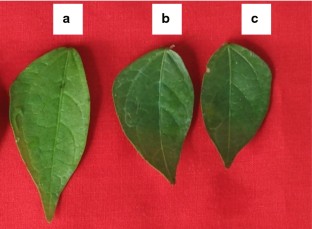Cross inoculation with beneficial Rhizobium strain promotes plant growth in Vigna mungo
Short Communications | Published: 22 May, 2019
First Page: 223
Last Page: 226
Views: 3836
Keywords: Cross inoculation, Plant growth promotion, Rhizobium aegyptiacum , Vigna mungo cv. T9
Abstract
Inoculation with beneficial microorganisms facilitates plant growth and is an alternative to chemical fertilizers for sustainable agriculture. In the present study, cross inoculation of Rhizobium aegyptiacum, an osmotolarant bacterial strain enhances growth in Vigna mungo cv. T9, a widely cultivated variety. In cross inoculated T9 plants, the stem length is increased in comparison to uninoculated plants and plants inoculated with the native Bradyrhizobium sp. Both the fresh weight and dry weight of root and shoot is higher in R. aegyptiacum inoculated plants as compared to Bradyrhizobium inoculated plants. Thus, R. aegyptiacum can be successfully cross inoculated in drought susceptible agronomically desirable black gram varieties for better growth.

References
- Ahmad I, Hayat S, Ahmad A, Inam A (2001) Metal and antibiotic resistance traits in Bradyrhizobium sp. (cajanus) isolated from soil receiving oil refinery wastewater. World J Microbiol Biotechnol 17:379–384
- Akhtar MS, Siddiqui ZA (2009) Use of plant growth promoting rhizobacteria for the biocontrol of root rot disease complex of chickpea. Aust Plant Pathol 38:44–50
- Ambede JG, Netondo GW, Mwai GN, Musyimi DM (2012) NaCl salinity affects germination, growth, physiology and biochemistry. Braz J Plant Physiol 24(3):151–160
- Bouraoui M, Abbes Z, Rouissi M, Abdi N, Hemissi I, Kouki S, Sifi B (2016) Effect of rhizobia inoculation, N and P supply on Orobanche foetida parasitizing faba bean (Vicia faba minor) under field conditions. Biocontrol Sci Technol 26(6):776–791
- Chaudhary S, Chakraborty D (2019) Screening of Vigna mungo (L.) Hepper varieties under drought stress. Plant Cell Biotechnol Mol Biol. 20(1–2):35–46
- Datta A, Singh RK, Kumar S, Kumar S (2015) An effective and beneficial plant growth promoting soil bacterium “Rhizobium”: a review. Ann Plant Sci 4(1):933–942
- De Souza R, Ambrosini A, Passaglia LM (2015) Plant growth-promoting bacteria as inoculants in agricultural soils. Gen Mol Biol 38(4):401–419
- Dutta P, Karmakar A, Majumdar S, Roy S (2018) Klebsiella pneumoniae (HR1) assisted alleviation of Cd (II) toxicity in Vigna mungo: a case study of biosorption of heavy metal by an endophytic bacterium coupled with plant growth promotion. Euro-Mediterr J Environ Int 3(1):27
- Gyaneshwar P (1999) Involvement of a phosphate starvation inducible glucose dehydrogenase in soil phosphate solubilisation by Enterobacter asburiae. FEMS Microbiol Lett 171:223–229
- Hossain D, Solaiman ARM (2004) Performance of mungbean varieties as affected by Rhizobium inoculants. Bull Inst Trop Agric 27:35–43
- Howieson J, Malden J, Yates R, Hara G (2000) Techniques for selection and development of elite inoculant strain of Rhizobium leguminosarum in South Australia. Symbiosis. 28:33–48
- Hussain A, Ali A, Khaliq T, Ahmed A, Aslam Z, Asif M (2014) Growth nodulation and yield components of mungbean (Vigna radiata) as affected by phosphorous in combination with rhizhobium inoculation. Afr J Agri Res 9(30):2319–2323
- Iqbal R, Mahmood A (1992) Response of Leucaena leucocephala to inoculation with rhizobia from tropical legumes. Pak J Bot 24:153–156
- Khetran AS, Ahmed M, Jakhro MI, Rahujo ZA, Jamali MH, Naseer NS and Sadiq N (2018) 34. Production efficiency of mung bean (Vigna radiate L.) through seed inoculation and NP application in Balochistan. Pure Appl Biol 7(2):700–705
- Kumari D, Chakraborty D (2017) Drought stress mitigation in Vigna radiata by the application of root-nodulating bacteria. Plant Sci Today 4(4):209–212
- Mahmood A, Athar M (2008) Cross inoculation studies: response of Vigna mungo to inoculation with rhizobia from tree legumes growing under arid Environment. Int J Environ Sci Technol 5(1):135–139
- Mandal SM, Chakraborty D, Dey S (2010) Phenolic acids act as signaling molecules in plant-microbe symbioses. Plant Signal Behav 5(4):359–368
- Perez-Montano F, Alías-Villegas C, Bellogín RA, del Cerro P, Espuny MR, Jimenez-Guerrero I, Lopez-Baena FJ, Ollero FJ, Cubo T (2014) Plant growth promotion in cereal and leguminous agricultural important plants: from microorganism capacities to crop production. Microbiol Res 169(5):325–336
- Solaiman ARM, Rabbani MG (2004) Effects of Rhizobium inoculant and nitrogen application on pea. Bangladesh J Microbiol 21(1):36–41
- Souframanien J, Gopalakrishna T (2006) ISSR and SCAR markers linked to the mungbean yellow mosaic virus (MYMV) resistance gene in blackgram [Vigna mungo (L.) Hepper]. Plant Breeding 125:619–622
- Sumithra P, Manikandan T (2016) Studies on isolation and identification of Rhizobium from agricultural soil and its effect on Vigna mungo, in pot culture experiments. Int J Res Medical Sci 3:37–49
- Taylor SR, Weaver BD, Wood WC, Edzard SV (2005) Nitrogen application increases yield and early dry matter accumulation in late-planted soybean. Crop Sci 45:854–858
- Youseif SH, Fayrouz H, El-Megeed A, Saleh SA (2017) Improvement of Faba Bean yield using Rhizobium/Agrobacterium inoculant in low-fertility sandy soil. Agronomy 7:2–12
- Zahran HH (2001) Rhizobia from wild legumes: diversity, taxonomy, ecology, nitrogen fixation and biotechnology. J Biotechnol 91:143–153
Author Information
Department of Bioscience and Biotechnology, Banasthali Vidyapith, Vanasthali, India